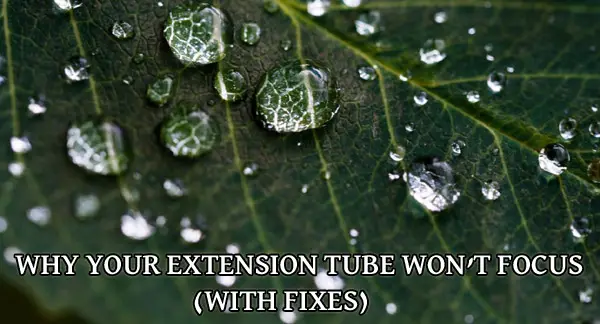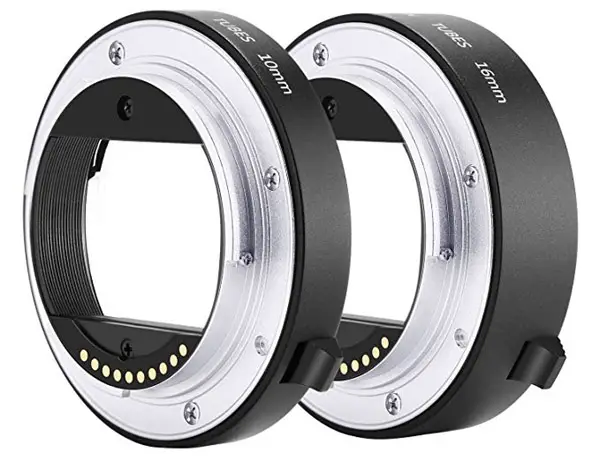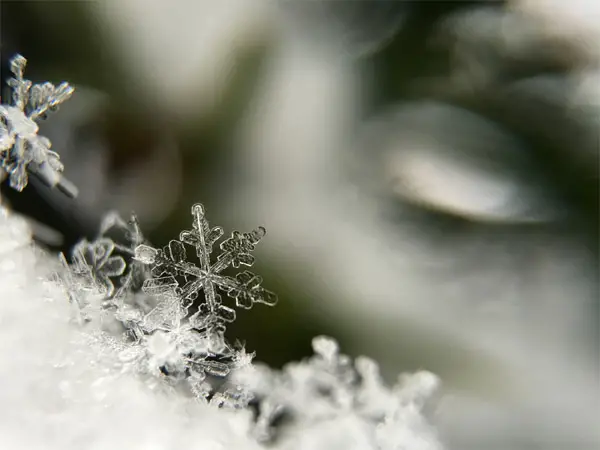You want to take a lovely photo of the delicate swirls of a seashell. The only problem is…you can’t figure out why your extension tube won’t focus. Macro photography takes you into the beautiful and enticing world of the minuscule. A dewdrop hanging from the end of a calla lily, an insect drinking nectar from a flower, the brilliant sparkle of the diamonds in a wedding ring — these photos are made possible by macro lenses.

But macro lenses are expensive so you may have opted to use an extension tube with a regular lens instead.
Both pieces of equipment allow the camera to get closer to the subject (and still focus on the object). Plus, they magnify the subject so you can see details that a normal lens wouldn’t be able to capture.
How does an extension tube mimic the look of a macro lens? This tube moves the lens farther away from the camera’s sensor, allowing you to get closer to your subject and increase the magnification.
However, if you’ve ever used an extension tube, you may have had trouble focusing it. Read on to find out why your extension tube won’t focus and, more importantly, how to fix it. An extension tube not focusing may have to do with the distance to your subject, choosing a different focal length, or buying extension tubes with the electric component.
What Are Extension Tubes?
An extension tube is an apparatus that you attach to your camera and then attach your lens to. It looks like a regular camera lens, but it’s missing one key component — the glass.

It’s literally a hollow tube whose purpose is simply to increase the distance between your lens and the camera sensor. The farther the distance, the closer the lens can be to the subject and the more magnified the subject will be.
In fact, the lens has to be closer to the subject than normal in order to focus. Thus, the first reason why your extension tubes may not be focusing correctly is that you are too far away. Try moving closer to your subject to find the focus.
Extension tubes are usually made from either plastic or metal. It’s common for them to come in a set of three with each one offering a different length. You can use them in any combination to create different distances from the sensor depending on how extreme you want your macro to be.
Calculating the Distance
How much magnification can you get with extension tubes? It varies depending on how long your extension tubes are and the focal length of the lens you’re using.
The math to figure out the magnification factor is pretty simple. Simply divide the length of the extension tube in millimeters by the focal length of the lens.
For example, say you combine a 25mm extension tube with a 50mm lens. 25 divided by 50 gives you a magnification factor of x0.5. This can also be written as a ratio 1:2, meaning that the object is projected at half it’s life-size onto the camera’s sensor.
To achieve a 1:1 ratio, or to take an image of the object at life-size, combine a 50mm extension tube with a 50mm lens. If you want to use a longer focal length and still get a 1:1 ratio, simply use a longer extension tube. Try 85mm of distance with an 85mm lens, 100mm of distance with a 100mm lens — you get the picture.
You can also literally magnify your subject by using a higher ratio. For example, use 100mm of extension with a 50mm lens. Then you can focus on bringing even tinier details to life.

Which Focal Lengths Work Best?
You can use extension tubes with virtually any focal length from wide angle to telephoto. Although, short to mid-range focal lengths tend to give the best results. Which focal length you should use depends on the type of photo you want to take.
Shorter focal lengths will give you more magnification. Longer focal lengths will give you more working distance, but the effect will be less macro-like.
Many people like to start with a basic 50mm lens. As a small, light lens, it’s easy to play around with. Plus, it’s easy to obtain a 1:1 magnification ratio without adding too much weight to the camera.
It’s important to consider the weight. Heavier cameras are harder to hold perfectly still and camera shake will already be increased because of the magnification.
Try experimenting with the lenses you own to get an idea of how photos will turn out at different focal lengths. Don’t forget to change up the distance on the extension tubes if you bought a set that allows you to do that.
Remember that changing the length of the extension tube also changes the working distance. You may need to move closer to your subject for it to be in focus.
Does Autofocus Work with Extension Tubes?
It depends on which type of extension tubes you buy. There are two types. Those that maintain the electrical connection between the camera and the lens — and those that don’t.
Let’s take a closer look.
Non-Electrical Extension Tubes
The main reason why you would buy non-electrical extension tubes is the price. You can find an inexpensive set for less than $10 (though we can’t vouch for the quality).
Unfortunately, there are a number of drawbacks, most notably you won’t be able to use autofocus nor will you have aperture control.
If you’re wondering why your lens won’t autofocus with the extension tube, this could be the answer. You bought extension tubes that don’t have the electrical components necessary for the camera to talk to the lens.
However, this isn’t too difficult to manage. You can still manually focus your lens, which is often easier with macro photography anyway. At this distance, you can also move the camera slightly closer or farther away from the subject to bring it into focus.
You can also still use the camera to handle exposure. Simply put in aperture priority or program mode.
Where you will run into a bigger problem is with aperture control. Without an electrical connection, the aperture of the lens will stay fixed and open at its widest point. This is not ideal for macro photography. The depth of field is tiny and smaller apertures give you the ability to bring more of the image into focus.
Though not as common anymore your lens may have aperture rings, which make this less of a problem as you can stop down manually. However, the image in the viewfinder will get darker and you’ll have a harder time seeing what you’re doing.
Inexpensive extension tubes without electrical contacts might be useful if you just want to play a little with macro photography without investing a ton. However, if you want to get creative with it, or simply be less frustrated, we suggest buying one with electrical contacts.
Electrical Extension Tubes
Electrical extension tubes allow the camera to communicate with the lens as normal. You’ll be able to control the aperture settings, as well as use your autofocus. Though you might find that manual focus is easier to use with macro photography anyway.
Surprisingly, you can find cheap electrical extension tubes for about $30. Again, we can’t vouch for quality on those.
Sometimes on cheap extension tubes, the electrical connections may not function correctly or may have trouble making contact. The tubes have also been known to break, potentially sending your expensive camera lens crashing to the floor.
Prices for extension tubes range up to around $100 for off-brands and about $200 for name brands. The quality varies and as with anything, you get what you pay for.
If you plan to do a lot of macro photography, choose quality tubes — even if they’re more expensive. You’re still saving a ton of money over buying a dedicated macro lens anyway and there is less risk of damaging your equipment.
Pros of Extension Tubes
As a method of doing macro photography without buying a macro lens, extension tubes are a good option. They are one of the only options that don’t involve putting more glass in the picture, thus reducing image quality.
Additionally, you can use them with different lenses and stack them to create different looks. Plus, you don’t have to do any extreme cropping (accompanied by a healthy serving of image quality loss) to emulate the look of macro photography. Instead, your photo will be an actual macro photo.

Ready to Experiment with Macro Photography?
We hope this article has inspired you to get out and experiment with macro photography. The world of the tiny is full of all sorts of interesting things.
Perhaps you’ve been wanting to dive into macro photography but the price of a dedicated macro lens has held you back. Extension tubes are an inexpensive way to initiate yourself.
Perhaps you already have the extension tubes but they sit lonely and forgotten at the bottom of your bag because you couldn’t get them to focus. Now you know how to deal with this issue.
Want to learn more about macro photography? Check out this beginner’s guide to macro photography.








